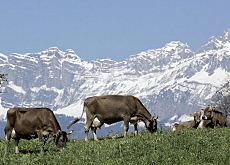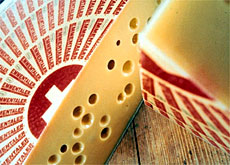Record growth in Swiss cheese consumption

The average Swiss gets through almost 20 kilograms of cheese a year, according to statistics released on Monday.
Cheese consumption was at a record high in 2005, with Italian interloper mozzarella topping the favourites, ahead of Swiss stalwarts Gruyère and raclette.
Fondues and cheese seem to be going down a treat in Switzerland with a record rise in cheese consumption recorded last year.
In total the Swiss put away 149,991 tons or 19.74kg a head last year – up 300g per person on 2004, said the Swiss Cheese Organisation.
The organisation’s director, David Escher, told swissinfo that Switzerland was in the upper half in terms of cheese consumption compared with other countries.
“If you look at the different European Union countries, there are countries where the per capita consumption is higher, for example France, where it is 27kg, but many countries are lower at 11-17kg,” he said.
Escher said the fact that Switzerland was a cheese-producing country accounted for the historically high levels consumed. He added that Swiss cheese also benefited from the trend towards healthy products because it was made from natural ingredients.
Last year’s rise was attributed to higher sales in Swiss cheese, which made up 79 per cent of sales.
Most popular
The most popular cheese however was found to be mozzarella at 2.26kg a head, followed by Gruyère (1.74kg) and raclette (1.35kg).
Escher said this was because mozzarella was often used as a convenience food, for salads and pizzas.
“It is an Italian product but it is now also produced in Switzerland and consumers also buy our Swiss mozzarella.”
In terms of categories of cheese, the Swiss preferred cream cheese (labelled as mozzarella, cottage cheese and mascarpone) at 6.34kg a head, followed by semi-hard varieties such as Appenzeller and raclette (5.59kg) and hard cheese such as Gruyère and Emmental (3.54kg).
Soft cheeses (1.72kg) and goat and sheep cheeses (0.12kg) were less popular.
Award-winning
The Swiss Cheese Organisation says that sales of cheese have risen 2.4 per cent since 2001 and that cheese production had also increased by 3.3 per cent to 167,706 tons in 2005.
In 2005 cheese exports rose by 2.4 per cent and imports by 0.15 per cent.
Swiss cheese enjoys a global reputation. An Emmental cheese crafted in Switzerland took top honours at the World Championship Cheese Contest in the United States in March.
The cheese had near perfect distribution of the holes that make it famous and a taste described by the top judge as “nutty and sweet”.
Escher is convinced that the Swiss cheese market has a bright future.
“We are very confident that this trend will continue for several reasons: the health aspect – our products are 100 per cent natural – and the trend for local products such as quality- labelled Gruyère, raclette and quality-labelled Tête de Moine,” he said.
“Although our products might be a little more expensive than the others, the quality is so good that we expect the boom to continue.”
swissinfo, Isobel Leybold-Johnson with agencies
Average cheese consumption per capita: 19.74kg.
The European Union average amount of cheese consumed per capita is reported at 18.9kg.
Favourite cheeses: mozzarella, Gruyère, raclette.
79% of cheeses eaten were Swiss made.
Many cheeses, such as Gruyère and Tête de Moine, have the quality label AOC.

In compliance with the JTI standards
More: SWI swissinfo.ch certified by the Journalism Trust Initiative












You can find an overview of ongoing debates with our journalists here . Please join us!
If you want to start a conversation about a topic raised in this article or want to report factual errors, email us at english@swissinfo.ch.